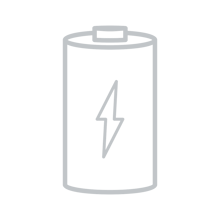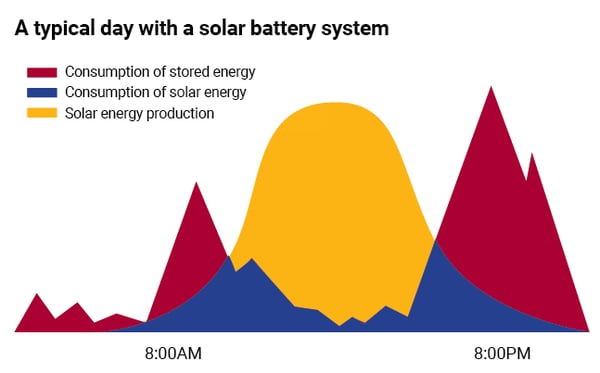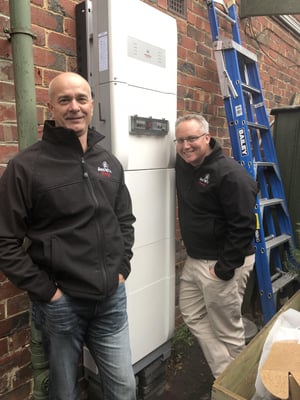|
Solar battery storage solutions have become a hot topic recently but despite the rapidly falling cost of technology, their financial viability is still up for debate. It’s important to make an informed choice when installing a battery storage system, so we have developed our Ultimate Guide to Residential Battery Storage to assist you. |
Is residential energy storage right for you? > The benefits of investing in battery storage > Financing solar storage and typical payback >  |
Is residential energy storage right for you?
Quick battery storage checklist – is solar battery storage right for me?
- Is your current electricity bill over $500 per quarter?
- Is your roof suitable for solar?
- Do you use most energy during peak times?
- Are you worried about continuously rising electricity prices?
- Are you in a regional area or impacted by blackouts?
- Do you have a well-ventilated space in your house or garage to install a battery?
If you answered ‘Yes’ to three or more of the above, a solar battery storage system could make sense for you.
As you are probably aware, batteries alone do not produce electricity, they simply store and release it. So, your first step should be determining your suitability for residential solar, click here to read our guide. When choosing a solar provider, preference should be given to a Clean Energy Council (CEC) approved solar retailer that provides quality products, has a proven track record and dedication to customer service. Select a supplier who can offer both solar and battery storage solutions rather than trying to find a separate battery provider as most reputable companies will not retrofit a battery into an existing system they have not installed.
Learn more about residential solar systems and the solar PV options available through Eko Energy >
Already have a solar system installed?
Generally, we do not recommend battery storage for older solar PV systems less than 4kW as you may not be generating enough excess energy to store in a battery. However, if you know you are exporting the majority of your generation, a battery could still be a good option. It’s possible to replace your existing inverter with a battery-ready inverter or a hybrid battery-inverter, but we recommend speaking to an expert to fully understand your options. The cost of a battery system alone can be broken down into:
- The battery itself
- A battery-ready inverter to convert DC to AC power
- A battery management system to monitor and control charging and power dispatch
- Installation
- Maintenance
As with any major purchase, be wary of providers offering cheap battery options, they are likely to be too small, have limited warranties or hidden costs.
Types of batteries
- Lead Acid
- Lithium-Ion the most popular choice for on-grid battery storage
- Flow
- Sodium Nickle Chloride
Suitable consumption profiles
The primary purpose of installing a battery storage system is to store any excess energy produced by your solar system, instead of feeding it back into the grid. This allows you to use more stored energy at times throughout the day or night when your solar panels are not producing energy. If you use most energy during peak times (early morning or late afternoon), or export most of your solar generation, a battery could be a good option.
The benefits of investing in solar battery storage
As electricity prices continue to rise and with the current lack of policy certainty, Australians are looking to take back control of their energy usage and become less reliant on the grid. Solar battery storage systems are an excellent way to secure a lower electricity rate long-term, while reducing your carbon footprint.
Store excess energy
If you are on a time-varying rate, electricity will cost more during peak hours and less during the daytime when your solar panels are at their most productive. Therefore, you could benefit from a battery storage system to store electricity generated by your solar system during the day and use it during peak times mentioned above.
Understanding time-of-use (TOU) electricity rates and feed-in tariffs
From 1 July 2018, the Essential Services Commission (ESC) has announced that energy retailers in Victoria must offer at least one of two feed-in tariffs (FiTs):
- the time varying FiT and/or
- the single-rate FiT
|
|
Off-Peak |
Shoulder |
Peak |
|
Time-Varying FiT |
10pm – 7am |
7am – 3pm & 9pm – 10pm |
3pm – 9pm |
|
Rates |
7.1 c/kWh |
10.3 c/kWh |
29.0 c/kWh |

You can see from this diagram that the average household will see consumption spikes first thing in the morning and again in the evening. These spikes are largely unaffected by solar generated during the middle of the day, using stored energy during the spikes makes a strong case for battery storage.
Understanding battery capacity
It's a common misconception that batteries can power an entire household. A typical battery can power household lighting and appliances (like your all important fridge and TV) but cannot power multiple air conditioning units or other high energy users like electric car chargers.

Prevent blackouts
With a standard solar system, you will still lose power during an outage because your panels are connected to the grid. However, when you add a battery, your home can use the solar energy stored in the event the grid goes down. Solar battery storage is more attractive than traditional diesel generators as they provide backup power without producing greenhouse gas emissions.
Reduce your carbon footprint
Going solar is a fantastic way to reduce your carbon footprint and consumption of electricity generated by fossil fuels. A 5.4kWh solar system typically generates as much energy as it takes to drive 2 cars for a year or represents the carbon sequestered by over 250 trees grown for 10 years!
Our CEO, Erik & Project Coordinator, Jack at a Redback installation
Financing solar battery storage and typical payback
Paybacks for solar and battery storage are different for every household and depend on your electricity usage over time, the price you pay for electricity and your system’s performance over and above the warranted specifications.
The good news is that batteries are now financially viable.
Eko Energy are offering an exclusive opportunity to finance a 6.4kW solar system + 4.8kWh Redback storage for as little as $29 net outgoings per month^.
|
REPAYMENTS |
ENERGY SAVINGS |
= $67 x84 MONTHS OUTGOINGS |
$29 x84 months net outgoings^
|
|
$208.40 x84 MONTHS |
$140.83 PER MONTH |
||
|
SOLAR VICTORIA SUBSIDY |
POWERRESPONSE CREDIT |
= $38 MONTHLY SAVINGS |
|
|
$2,225 |
$1,000 |
^Terms and conditions apply. Based on 28 c/kWh electricity rate, 84 month finance term, 8% annual increase in electricity prices, 0.5% annual solar degradation rate, eligibility for the maximum Victorian Solar Homes subsidy and EnergyAustralia's PowerReponse program.
PLUS if the Victorian Labor party win November's election, there will be an additional subsidy of $4,838 for the first 10,000 households to install battery storage.
Eko Energy are making solar and battery storage affordable.
Make the most of our PowerResponse program and get $1,000 upfront discount for switching to EnergyAustralia plus an additional $120 per annum minimum over 3 years.



